I have had both a brown pony (no black points-not a stitch of black–all chocolate brown w/mealy muzzle) and a black (visually looks darkest seal brown–but tested aa). Those two have a half sibling that is bright red bay (technically shows characteristics of wild bay). The all have the same mother but different fathers.
[QUOTE=stoicfish;8129028]
Possibly but what if it is a difference in the E gene that allows it to be resistant to the Agouti?
Of course it will only show up along with the Agouti gene…
I know the rest of it and how it works. That is why a chestnut horse and a black horse producing a brown could revel if it is connected with the E.[/QUOTE]
I’m not going to lie, I really have no idea what you’re trying to say. All horses carry agouti. But agouti works on black pigment. On a chestnut horse, there is no black pigment to work on, so you can’t tell what the agouti status is. Agouti is not “connected” to extension, they just work together to create the base colors.
[QUOTE=epowers;8129180]
I’m not going to lie, I really have no idea what you’re trying to say. All horses carry agouti. But agouti works on black pigment. On a chestnut horse, there is no black pigment to work on, so you can’t tell what the agouti status is. Agouti is not “connected” to extension, they just work together to create the base colors.[/QUOTE]
Ok dominate A Agouti, to be technical as opposed to “a” recessive Agouti.
Not every horse carries the dominate A. Of course they all have one form or other. Is that clearer?
Thus to obtain a comprehensive Agouti allelic status (when it cannot be deduced from the breeding records), one has to perform two DNA tests, both offered by PDSAz:
1.The standard/conventional Agouti test, specific for the recessive ‘a’. Everything that is not ‘a’ is interpreted as ‘A’ (but can be either bay-A, or seal brown-At).
- The At-specific test will differentiate between bay A and At (this test done alone cannot distinguish between bay ‘A’ and ‘a’).
This is interesting. They do not actually test for A just a.
No, my confusion stems from the fact that you seem to think that somehow extension is involved in making a bay/brown horse, and that you think a black horse can “carry” brown.
If you’re just trying to say that there is likely another pigment-type switch working in conjunction with extension and agouti to create the difference between brown and bay, then yes, I agree.
FWIW, I had our three chestnut breeding horses tested via PetDNA, and they all came back AAt, which seemed kind of like an ass-covering result to me, but isn’t implausible. I guess I’ll find out if I ever get a clear bay by breeding my mare to a black stallion!
E?At? x E?At? = chestnut (eeAt?) or black (E?aa) or brown (E?At?). You cannot get bay from this cross.
eeAta x eeAta = eeaa? is that right?
(my horse http://www.pedigreequery.com/whataboutfreud)
Your eeaa outcome is just one possibility. The others are eeAta and eeAtAt.
[QUOTE=stoicfish;8129198]
This is interesting. They do not actually test for A just a.[/QUOTE]
Right - they see (at least until recently) a and At, and anything else was assumed to be A. All other places are also only looking for a, and assume everything else, including At, is A, which is why all brown horses at, say, UC-Davis, test as bay.
[QUOTE=epowers;8129214]
No, my confusion stems from the fact that you seem to think that somehow extension is involved in making a bay/brown horse, and that you think a black horse can “carry” brown.
If you’re just trying to say that there is likely another pigment-type switch working in conjunction with extension and agouti to create the difference between brown and bay, then yes, I agree.
FWIW, I had our three chestnut breeding horses tested via PetDNA, and they all came back AAt, which seemed kind of like an ass-covering result to me, but isn’t implausible. I guess I’ll find out if I ever get a clear bay by breeding my mare to a black stallion![/QUOTE]
No I don’t think that extension is involved in making a bay/brown horse, and that you think a black horse can “carry” brown in the way you think.
I think it may be that there is a version of the Extension that the dominate A doesn’t supress. I know this is probably not as likely as it being caused by the Agouti.
So which side of that cross you described carried the brown phenotype?
While I guess it’s not IMpossible, Extension has been studied very well over many species and it is either on or off, products black pigment or doesn’t. Eumalin is eumalin. It’s the eumalin that is affected by Agouti. It is the species which determines what that effect looks like.
I’m still confused - what situation(s) has led you to wonder if there’s a 3rd form of Extension?
As for epowers saying “If you’re just trying to say…” then…I don’t know if what’s what will come out of what PetDNA (and presumably others) are working on with the possible “combination” gene of At and a (there are other possibilities, that’s the one most suspected), but given what’s already very well known about Agouti, having a attached to anything else doesn’t matter, because a is inactive in terms of black pigment. Is there another switch that affects shade? Absolutely I believe there are multiple other factors that govern shades. Are they the same whether it’s creating the range of shades of bay or the range of shades of chestnut? I don’t have any thought one way or another. For all we know - and some think this is possible - those shades are all some activation(s) of sooty, whether sooty is 1 gene or multiple.
So which side of that cross you described carried the brown phenotype?
Was the parentage of the 3 chestnuts given? I must have missed it
[QUOTE=stoicfish;8129028]
Possibly but what if it is a difference in the E gene that allows it to be resistant to the Agouti? [/QUOTE]
Coming back to this in light of my last reply:
It’s not that Agouti acts on the Extension gene to control how much black pigment is produced, which is what I think you are thinking.
The E form of extension produces black pigment all on its own. It’s what it does.
Then Agouti - in whatever form - comes along and “covers up” some of that pigment that’s already produced. In a bay, that means it says “Black pigment, you are forbidden from the hairs on the main body. But go ahead and do your thing on the legs and mane and tail. I’ll let you and the rest of your groupies decide how high up the legs you want to go.”
[QUOTE=stoicfish;8129523]
So which side of that cross you described carried the brown phenotype?[/QUOTE]
Oh, is this the scenario you were referring to?
If so, then the brown 100% came from the chestnut dam. There isn’t any other option, as a black horse is aa - no bay A, no brown At, no (theorized) wild bay A+.
But that’s all you know about the chestnut mare (barring the subsequent testing). You only know - from that single breeding - she carries At.
Now if a subsequent breeding to a black stallion produces a bay horse, then you know without even testing she is AAt.
However, if subsequent breeding to a black produced a black foal, then she would have to be Ata - the At is what produced the brown foal, and the a is what produced the black foal.
So I had to look this up because I didn’t know but thought it might be something similar.
The Agouti locus is occupied by the Agouti signalling peptide (Asip) gene, which encodes the eponymous protein (ASIP). Agouti signalling peptide is a paracrine signaling molecule that competes with alpha-melanocyte stimulating hormone (?-MSH) for melanocortin 1 receptor proteins (MC1R). MC1R relies on ?-MSH to halt production of red-yellow pheomelanin, and initiate production of black-brown eumelanin in its place
(? is equal to the alpha symbol)
So my thought was (without knowing the details but guessing at the general mechanism) that the binding site of the ASIP that typically blocks is not functioning the “normal” way.
The probable scenario it would be the protein ASIP that is altered (the ASIP which would mean the issue is with the Agouti) or less probable but possible is with the receptor site, as it may have been altered so the ASIP is less functional/binding. Assuming the receptor site protein is linked to the Extension.
I just read all this so I am not pretending that I have the best understanding but that was what was behind my thinking…but with specific detail.
But if you found a case as above and the only brown horses were on the black side, then my far fetched idea might be possible. Hence me asking… 
Here is our new Section D Welsh Cob filly. I’m 99% sure she is a brown dilute, but so frustrating that there is no test for it yet.
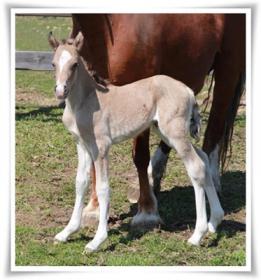
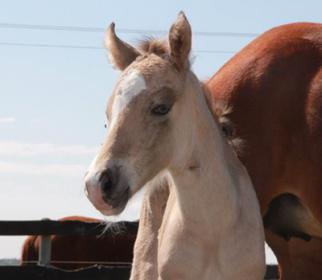
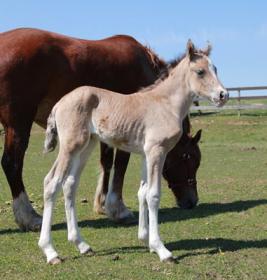
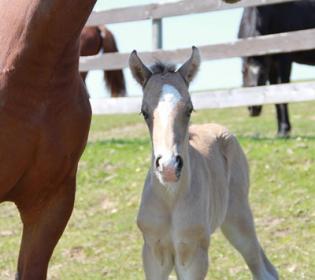
How adorable!! I too am leaning towards brown but really would not be surprised with buckskin.
Is there a newborn but dried off picture ? How old is she in these?
Her new shed will be a lot more telling I think.
[QUOTE=JB;8145354]
How adorable!! I too am leaning towards brown but really would not be surprised with buckskin.
Is there a newborn but dried off picture ? How old is she in these?
Her new shed will be a lot more telling I think.[/QUOTE]
She’s about 20 hours old in those pictures.
[QUOTE=JB;8145354]
How adorable!! I too am leaning towards brown but really would not be surprised with buckskin.
Is there a newborn but dried off picture ? How old is she in these?
Her new shed will be a lot more telling I think.[/QUOTE]
She is 20 hours old in the photos.
Hard. On one hand I lean towards buskskin because of how clear her color is. But OTOH brown because of what looks like some face masking.
Any news on testing for the brown (At) gene? I just went to the Arizona lab’s website which seems to be defunct.
Our girl definitely seems to be a brown dilute. No black points whatsoever. Would love to get her tested. I contacted UC Davis, but they are not working on this gene, nor is anyone else.
I guess for now, we just call her buckskin.  It is a beautiful color…whatever it is!
It is a beautiful color…whatever it is!
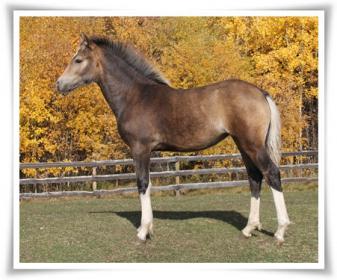
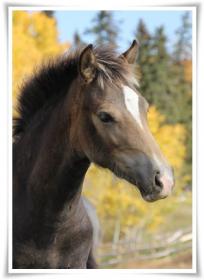
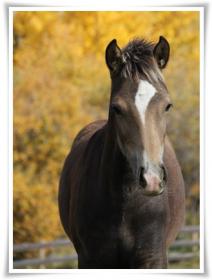
I would certainly call her smoky brown until proven otherwise  But I understand calling her buckskin too - safer if it’s a sale issue.
But I understand calling her buckskin too - safer if it’s a sale issue.
I have not heard anything more about additional/modified brown testing 
Does she have any dun-like markings? Any good dorsal stripe or anything?
There’s a newly discovered version of the Dun gene - nd1 - which is proving to produce dun-like markings in the abscence of dun. So D is Dun, nd1 is this new discovery where it’s a non-dun dilute but had primitive markings, and nd2 is non-dun without primitive markings. It’s answering a lot of questions for some people whose horses look SO dun, but also don’t, and had previously tested dd. Anyway, Practical Horse Genetics is looking for samples to get their own test going (UC-Davis has it now).
She’s keeper for us, as she is an outcross for our Section D stallion. She does have a brown dorsal stripe, but no other dun-type markings.
I have a similar filly - brown bucksin (tested to carry the creme gene) out of a brown dam and she is a similar color - glad to see other cool colored pomies out there!
